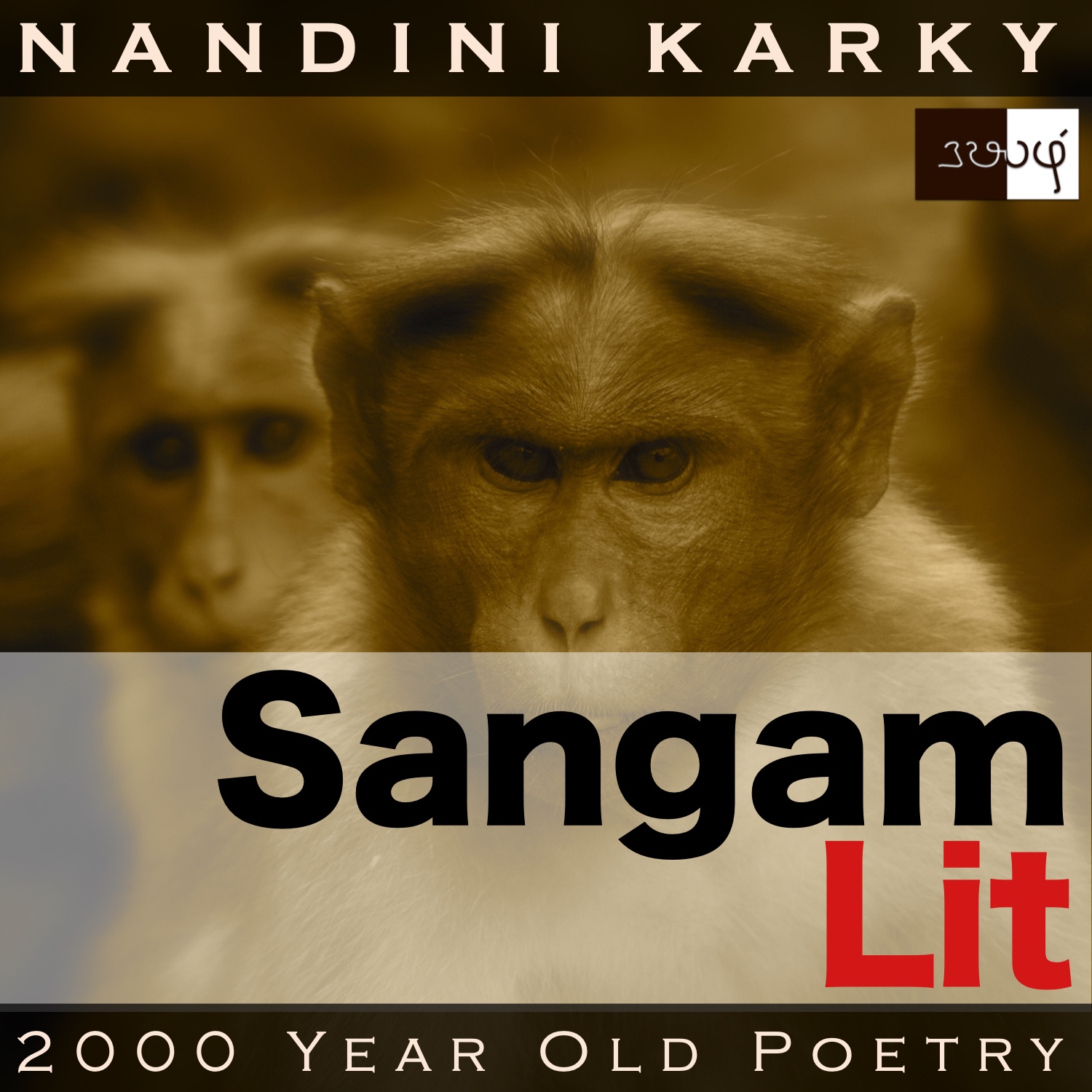Podcast: Play in new window | Download
Subscribe: Apple Podcasts | Spotify | Amazon Music | Android | iHeartRadio | TuneIn | RSS | More

In this episode, we unravel the layers of culture and meaning depicted in Sangam Literary work, Natrinai 57, written by Pothumpil Kilaar, this being his only Sangam poem. Set in the ‘Kurinji’ landscape of mountain country, the poem speaks in the voice of the lady’s confidante, conveying a subtle message to the man about the impending changes in their love life.
தடங்கோட்டு ஆமான், மடங்கல் மா நிரைக்
குன்ற வேங்கைக் கன்றொடு வதிந்தென,
துஞ்சு பதம் பெற்ற துய்த் தலை மந்தி
கல்லென் சுற்றம் கை கவியாக் குறுகி,
வீங்கு சுரை ஞெமுங்க வாங்கி, தீம் பால்
கல்லா வன் பறழ்க் கைந் நிறை பிழியும்
மா மலை நாட! மருட்கை உடைத்தே-
செங் கோல், கொடுங் குரல், சிறு தினை வியன் புனம்
கொய் பதம் குறுகும்காலை, எம்
மை ஈர் ஓதி மாண் நலம் தொலைவே!
The poem felt so much like a safari through an unseen mountain country packed with animal sightings. First animal spotted is the ‘ஆமான்’ or the ‘bison’. Next animal is ‘மடங்கல்’ or ‘lion’. Lovely to learn new words from these ancient poems. Seems to me like I’m learning my mother-tongue anew as if it’s a foreign language. Getting back to the world of animals, there’s the ‘மந்தி’, the female monkey, upto something crafty! Leaving behind the jungle teeming with these animals, we enter a millet field in the mountain country, when we see the words ‘சிறு தினை வியன் புனம்’. Finally, the poem finishes with the reference to the lady as ‘மை ஈர் ஓதி’ meaning ‘woman with cool, dark tresses.’ Animals, millets and my lady – let’s find out how and where they all meet!
We learn that the man and the lady have been in a relationship during the time she was guarding the millet fields. One day, when the man arrives to meet with the lady, the lady’s confidante intercepts him and passes on a message, by saying, “O lord of the mountains, in whose land, lions and many other dangerous beasts roam. In your mountain peak, under the shade of a ‘vengai’ tree, there stays a female bison possessing curved horns, with her calf. Seeing the bison asleep, a female monkey possessing soft, cottony hair, makes a sharp, soft sound and bending its arms, silences its many kin. Then, it sneaks close and presses the swollen teats of the sleeping bison and squeezes the sweet milk to fill the cupped hands of its young one, which cannot fend for itself. Coming to the land here, all over the millet field, the crops are well grown, with their red stalks and curved ears. This heralds the harvest season. I’m bewildered seeing this, for I worry about the health and beauty of your lady, possessing cool, dark tresses!” Now, why the detailed description about the land where the man comes from? Does he not know his own country? And then again, so what if the millet crops are all grown up and to be harvested? What has that got to do with our lady’s health? Questions abound!
To see the answer, we need to appreciate both the cultural practices of then, as well as the poetic tool of hiding a message in the description of a natural scene. First, I wish to call your attention to the thread that connects the elements in an outer, skin-deep way. First, the female bison is said to have a curved horn, followed by the female monkey, described as having cottony hair and then finally, the lady is described as one with dark, cool tresses. Thus, a neat line runs through the poem, connecting all of its female protagonists. Moving on to deeper things, the poem brings before our eyes, a drama happening in the wild world. A scene fit to be in the best shows of ‘Animal Planet’. Glimpses of what a wild country it is, is shown by depicting perhaps the footprints of lions and other dangerous beasts that rove during the night. Then, adding on to the inherent danger, we see a ‘vengai’ tree, an Indian kino tree, which is used as an equivalent of a ‘tiger’ in these poems. And yet, inspite of all the looming danger, under the shade of such a tree, a female bison sleeps with its calf. Just then, tiptoeing into the scene and thoughtfully silencing its jabbering relatives, the female monkey steals into our frame. It’s got a young one on its back, all frail and still learning. Caring mama, sneaks in for a booster shot of bison milk for the young ‘un! And it squeezes the milk from the sleeping beast and feeds its young one. This is a metaphor for how the man must brave the dangers of the drylands to go seek wealth and then come ask the lady’s hand in marriage.
Now, coming to what the millet field has got to do with our lady, it was the custom then to have young girls guard the millet fields and chase away birds that come to feed on the crops. Being away from home, the lady meets with her man and unites with him. So, when the season of harvest is here, her time alone is over and she has to return to the protection of her home. So, the lady’s confidante is simply conveying that if he wants to meet with his lady, it’s not going to be an easy task anymore and he needs to brave the dangers in his path to earn the joy he yearns for. Not minding the dangers around, the female bison sleeps and loses its milk to the monkey. Whereas the monkey braves the dangers around and smartly steals what she wants. The lady’s confidante is showing the way forward to the man, with this etched screenplay in the natural world. A poem that seems to tell us, courage is key!




மனிதன் குறிப்பாக காதலர் இற்கையைப் பார்த்து புரிந்து மேற்செல்லவேண்டியதை உணர்த்தும் பாடல்